At the 2022 D23 Expo, Chairman of Parks, Experiences, and Products Josh D’Amaro was on hand to unveil the roster of projects that would roll out across Disney Parks for the ensuing half-decade. Especially given the three year lapse since the previous D23 and the catastrophic fallout of the pandemic in the meantime, the event was expected to serve as a venue for (re)announcements, status updates, and – hopefully – the long-awaited reveal of the next wave of mega-projects earmarked for the parks.
Strangely, practically nothing unknown of significance was revealed at the event (leaving Disney Parks’ post-2024 public timeline entirely empty), perhaps owing to then-new CEO Bob Chapek‘s expressed preference for high-yield merchandise, low-risk meet-and-greets, inexpensive IP overlays, and the focused machinations of the cross-promotional “synergy machine” and “franchise flywheel” he often, awkwardly spoke of. In other words, Chapek’s vision positioned Disney Parks as elaborate “brand loyalty centers” where Disney + Pixar + Marvel + Star Wars can be readily consumed – with nearly every recent move at California Adventure as a prime example.
Maybe that’s why the park eked out two quasi-announcements…
202X – Avengers Campus, continued
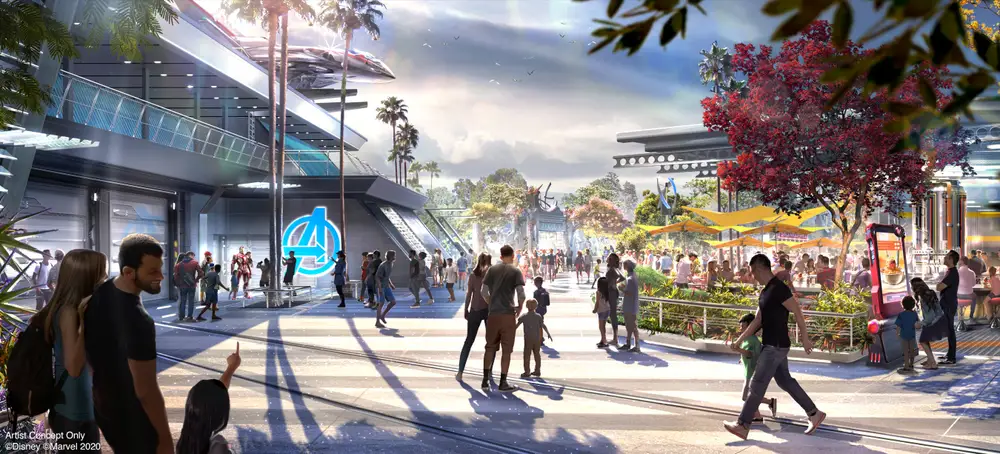
The first is the one we’ll have to wait for. At long last, 2022’s D23 Expo finally provided an update related to Avengers Campus’s once-promised anchor ride – that full-fledged, Avengers-style crossover attraction. When it was announced by then-Parks-Chairman Chapek back in 2019 as a Phase II expansion of the land, the Avengers ride was believed to be not just an anchor for the land, but a new headliner for California Adventure; its Rise of the Resistance caliber “U-Ticket” thrill ride that would send guests to join Marvel heroes in a battle for Wakanda aboard an ultra-complex ride system.
For many reasons, it makes sense that that ride was dead on arrival by 2022. For one, then-firmly-planted-CEO Chapek would no doubt balk at another Rise of the Resistance-level technological and financial investment post-COVID. But likewise, the 2020 death of Black Panther star Chadwick Boseman no doubt made the ride’s Wakanda focus untenable.
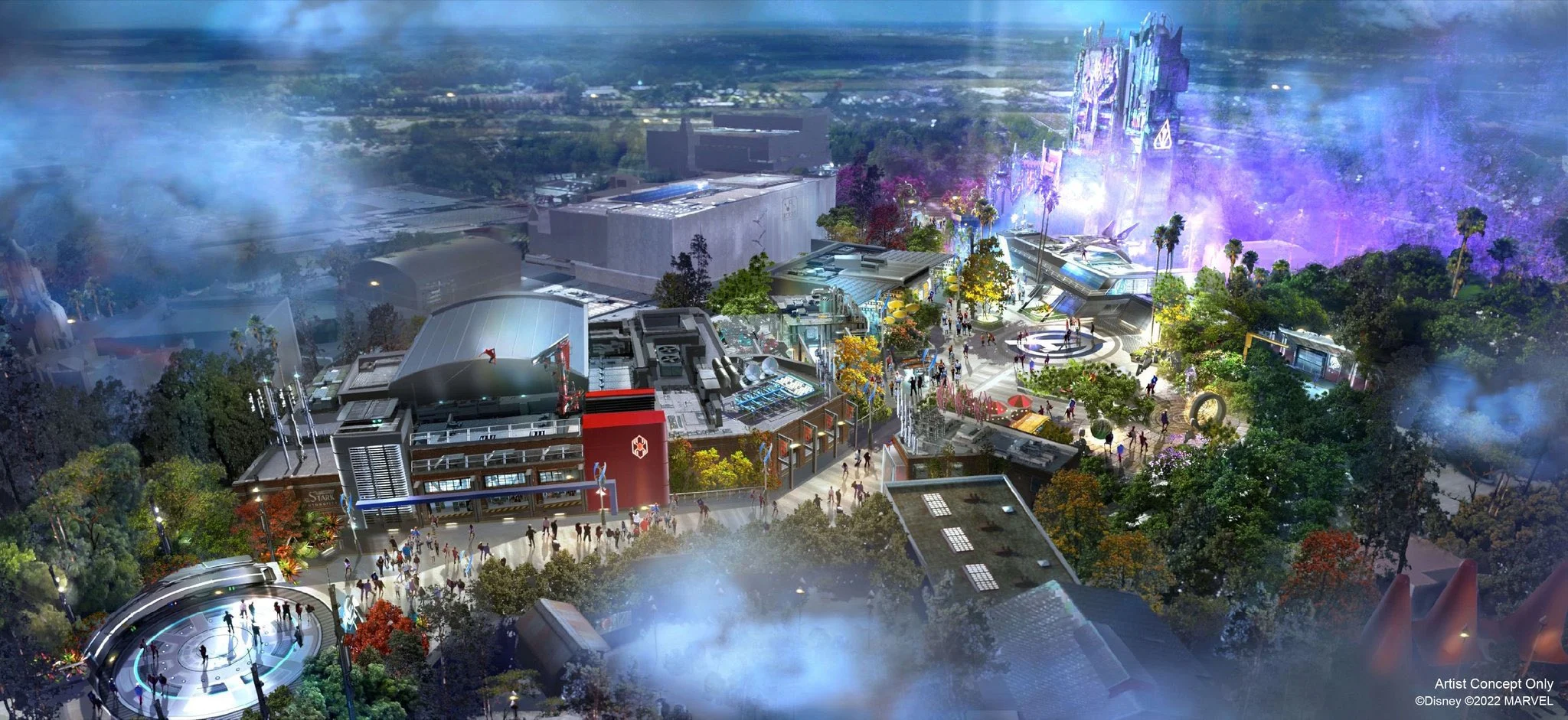
Plus, frankly, given the MCU’s breakneck pace, it would probably be unwise to set an anchoring ride so firmly in the “Infinity Saga” when Iron Man, Black Widow, Thor, and Captain America would star when the MCU has moved on to its next twenty-film arc, the “Multiverse Saga.” A headlining ride for Avengers Campus needed to not only harken back to the original heroes fans would never forget, but to embrace the unknown (and highly episodic) nature of the MCU going forward.
So it wasn’t incredibly surprising that revised concept art (above) axed the looming, white Avengers compound showbuilding and instead opted for an otherworldly, “Multiversal” purple mist obscuring the last of California Adventure’s sizable expansion pads.
Marvel Studios’ executive Kevin Feige dropped into the Parks Presentation to announce the land’s redeveloped (and unspoken: scaled back) Avengers ride. The new attraction would see guests encounter a Multiversal variant of the Infinity Saga’s legendary “big bad,” Thanos, with this version of the character arriving in Avengers Campus from an alternate reality where he successfully defeated the Avengers and conquered Earth, now setting his sights on our universe.
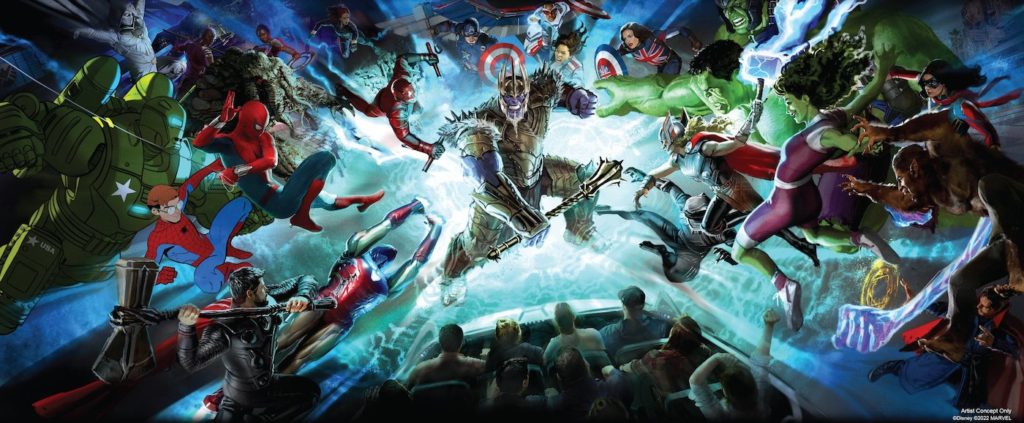
What will follow is… well… no one’s quite sure. Chapek did promise that heroes “from anywhere” will join the fight, as evidenced by a single piece of concept art. In it, heroes from throughout the MCU and adjacent Multiverses appear – like three “Captain America” variants drawn from different times and realities (Sam Wilson, Steve Rogers, and Peggy Carter), two Spider-Men (the MCU’s as well as an animated variant), two Hulks, She-Hulk, Daredevil, Man-Thing, Thor, and The Mighty Thor, Black Panther, Moon Knight, and more.
Rather than a technological, thrilling, cutting edge “U-Ticket,” the reimagined Avengers E-Ticket was described as a “family” attraction – a somewhat wilting descriptor for an IP and land that could really use something revolutionary and headlining. In any case, the Avengers attraction is still years away, and aside from concept art that suggests a SCOOP-style dark ride or perhaps a Gringotts-style coaster, we don’t really know what it’ll be like. So we’ll just have to wait.
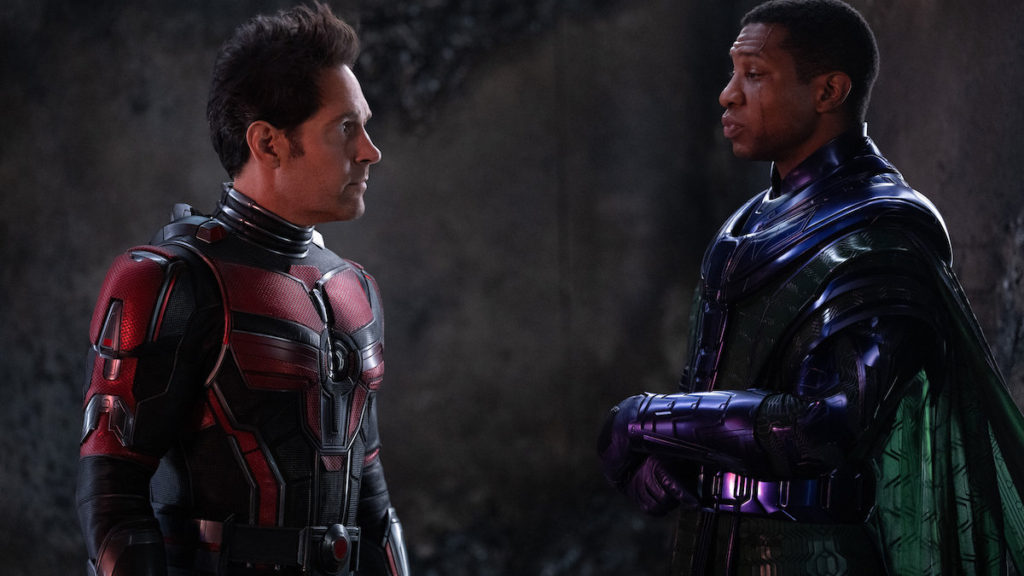
Frankly, that’s increasingly seeming like a dangerous proposition given that Marvel’s once-unbreakable streak of billion-dollar-earners has been broken by a series of worrying under-performers and what some industry insiders call “superhero fatigue.” Under returned-CEO Iger, Marvel is entering a period of strategic retraction, meant to reduce costs by slowing the studio’s roll, reducing its output, and pulling back the reigns on Marvel’s legendary and long-untouched production budgets. Does that mean a slow-down on Marvel rides as well? And what might it mean if Disney smells the end of Marvel’s pop culture dominance altogether?
In other words, we may discover that even Marvel isn’t immune to the downside of building permanent lands based on fleeting franchises. Nothing lasts forever. Even the reign of Marvel superheroes. Until then…
2023 – San Fransokyo Square
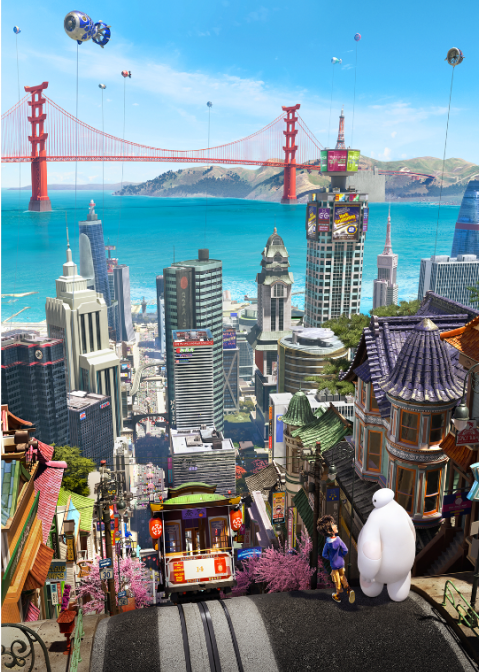
Just as the hefty price tag of Pixar inspired Disney to dig deep for ways to utilize the studio’s characters, the 2014 animated film Big Hero 6 actually originated in an all-call to find relatively unknown characters and stories in the Marvel canon that could be adapted across Disney’s studios. The Academy Award-winning film focuses on the story of teenage tech whiz Hiro Hamada and his inflatable “healthcare companion,” Baymax, as they inadvertently get caught up in a supervillain’s schemes and turn a group of ragtag teens into a team of high-tech heroes.
Compelling as the film and its cast are, there’s no question that one of the movie’s standouts is the world it takes place in: the city of San Fransokyo – a sort of retro-futuristic, near-future-set fusion of California’s already-eclectic Bay Area with Japanese-inspired architecture, culture, cuisine, and superhero-tech. This multiversal variant of San Francisco has a history all its own, beginning with the real 1906 earthquake that struck the city, causing cataclysmic damage. In this alternate reality, it was Japanese immigrants who set to work, using Eastern architecture and engineering to stabilize the city and set San Fransokyo on a new course, becoming a technological centerpiece of the globe.
A dynamic, electric, retro-futuristic pop metropolis, San Fransokyo is a vibrant coastal city of skyscrapers, tethered & floating wind turbines, cherry blossoms, historic trolleys, Shinto shrines, LCD screens, and advanced laboratories maintained by students of the San Fransokyo Institute of Technology. Rich, cultural, and cutting-edge, Big Hero 6 presents San Fransokyo as a vast and exciting world.
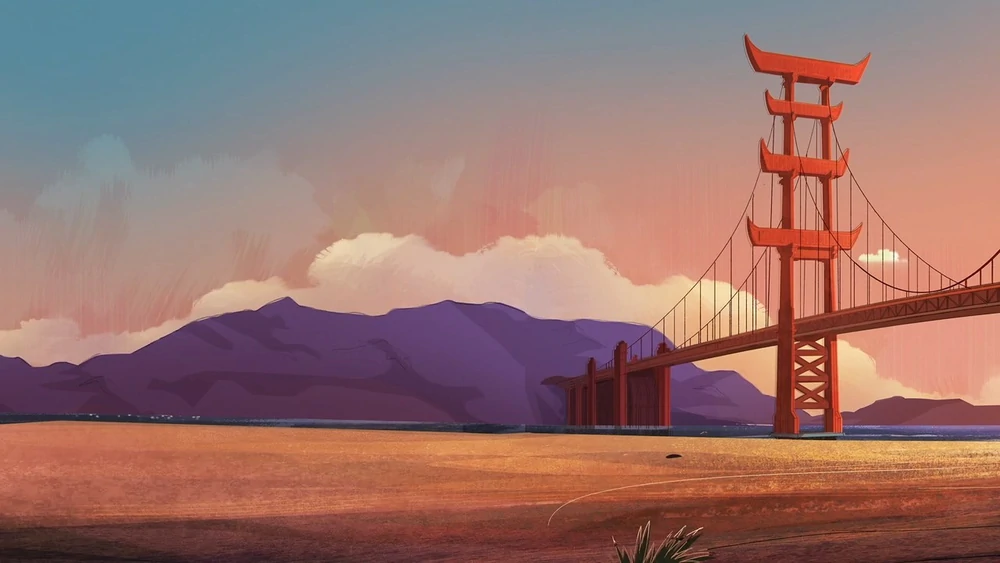
And frankly, San Fransokyo would make for a fantastic land at California Adventure – a modern-day, IP-washed version of the Possibilityland: Discovery Bay, serving as the park’s equivalent of a comic-book-infused cityscape mixed with the plucked-from-the-screen style of Cars Land. Highly distinct, highly diverse, and highly Californian, San Fransokyo has all the makings of a good fit for the park – rich, textured, cultural, historic, idealized, and filled with character.
For that reason, fans might’ve been momentarily stunned when – at the D23 Expo in 2022 – Josh D’Amaro almost casually breezed by the announcement that a new San Fransokyo land was en route to Disney California Adventure.
Especially for Park Lore readers (who hopefully saw my plans for a fully-immersive Big Hero 6 land as part of my from-scratch concept park, Disney’s Fantastic Worlds) San Fransokyo conjures images of a Cars Land-scaled expansion and a KUKA Robo-arm dark ride sending guests flying through the streets alongside the Big Hero 6 team. In other words, it sounded like a windfall for the park… until D’Amaro revealed the art.
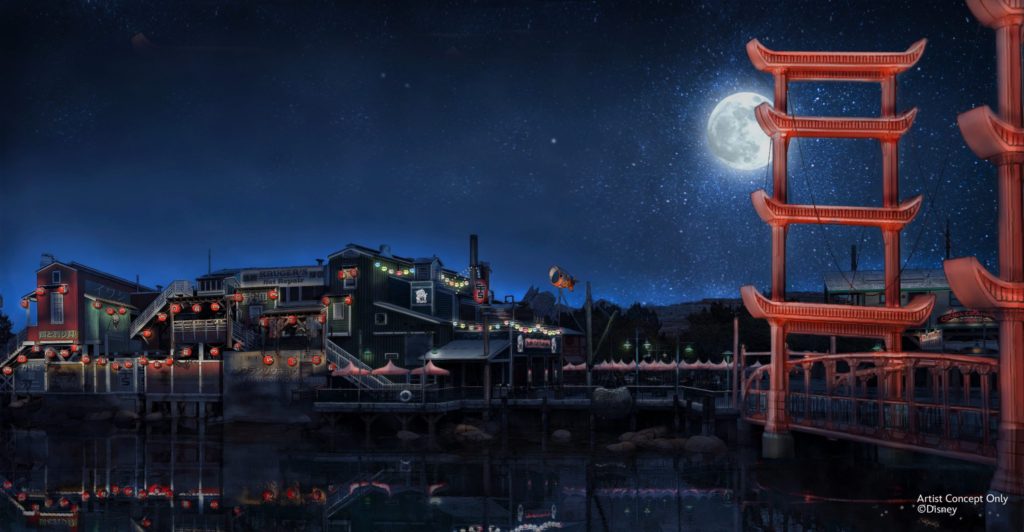
In a breath, D’Amaro announced that San Fransokyo would merely be a transformation of the park’s existing Pacific Wharf – an area that had been a part of California Adventure since its opening. Back in 2001, Pacific Wharf had been one of the visual stand-outs in “DCA 1.0” thanks to its coastal warehouses (recalling Monterey’s Cannery Row) and its myriad of international quick service eateries.
Even though it didn’t contain a ride (and didn’t have any space available to house one even if it wanted to), Pacific Wharf “graduated” to full “land” status as part of the park’s 2012 relaunch. Now, one of the few remaining untouched corners of California Adventure would receive its own mandated IP tie-in, renaming and re-stylizing itself after Big Hero 6.
(One grateful edit since the land’s announcement at D23 was that its name was changed from “San Fransokyo” to “San Fransokyo Square” – a simple but really necessary modifier that communicates that this space is not even trying to be the vibrant, sprawling, modern metropolis we saw in the film that it’s demonstrably not. Instead, San Fransokyo Square signals that this is just one small part of the city – its wharf – while the rest of San Fransokyo is just “off-screen” and out of our view.)
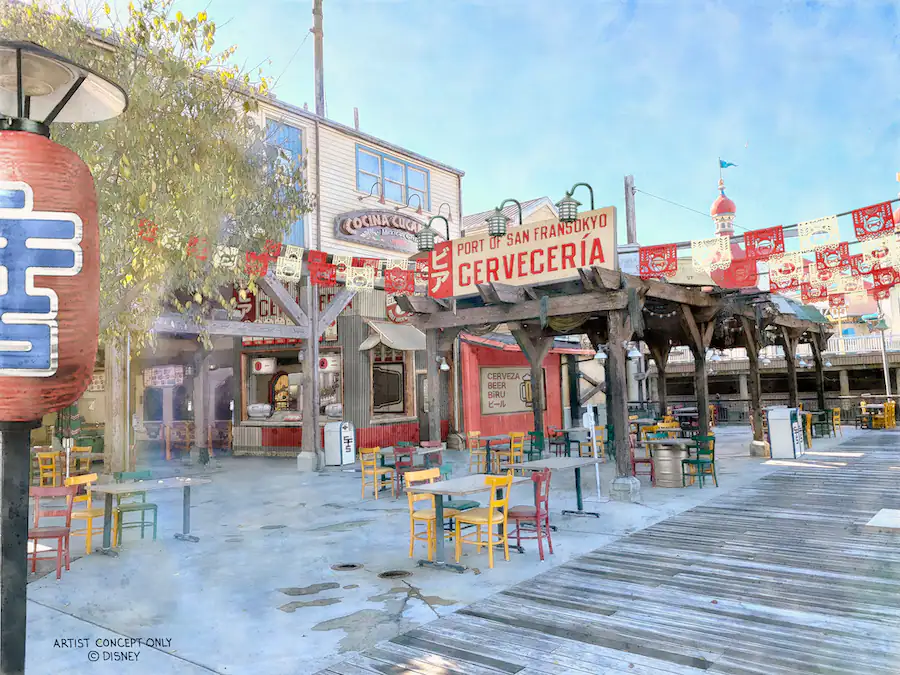
According to its WDI-required, in-depth backstory, San Fransokyo Square is meant to communicate a dense history for the wharf district of town – that as San Fransokyo’s fishing and canning industries dried up, tech moved in and “entrepreneurs came together to reinvent the seaside canneries into a vibrant, multicultural district of neighborhood restaurants and small businesses where you’ll be able to eat and shop.”
That also allowed the structures and restaurants of Pacific Wharf to be swirled into Disney’s favorite in-park aesthetic (adaptive re-use of abandoned warehouses) and its favorite in-park narrative (that you’re visiting and supporting small, minority-owned businesses with their own embedded histories) du jour.
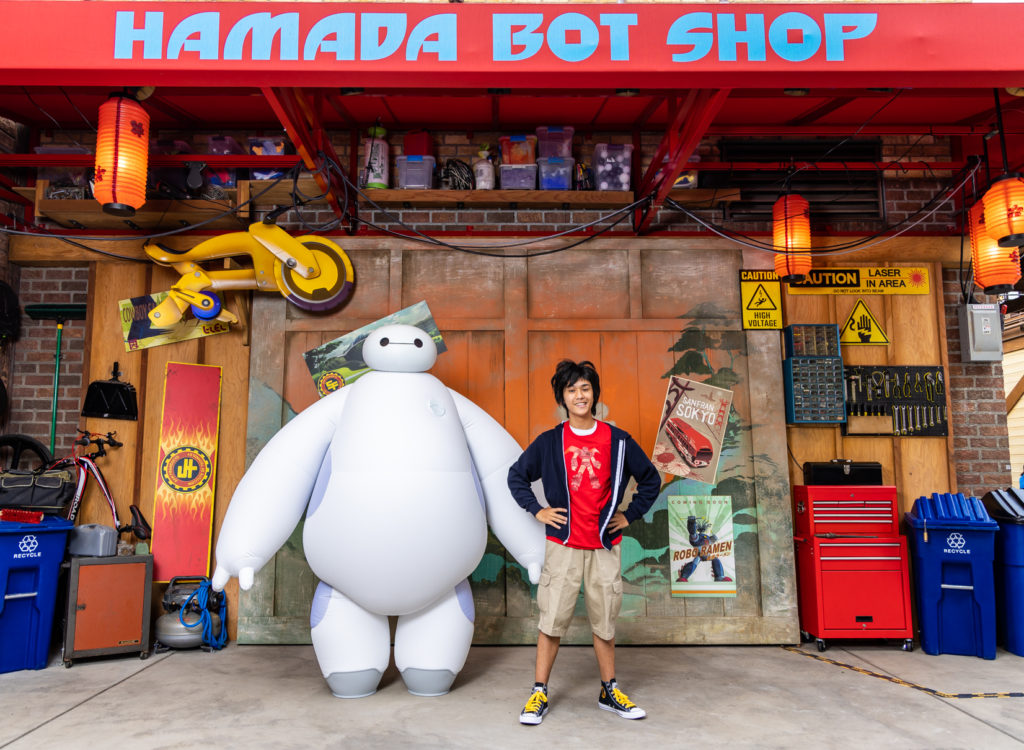
San Fransokyo Square, then, can retain Pacific Wharf’s Mexican and Asian quick-service eateries, its bakery, its chocolate shop, its beer garden, and its margarita stand, with just placemaking, the embedded backstory, a new “Maker’s Market” retail stall, and a Baymax meet-and-greet to provide anything of substance to the “reimagining.”
Still, one has to wonder: does stringing paper lanterns and painting Japanese signage over a food court really embody San Fransokyo in any meaningful way? Cynics might argue that in this form, “San Fransokyo Square” is a “label slap” that only the Chapek regime could produce. Which is a real shame, because of all of the animated worlds you’ll find in Disney California Adventure, San Fransokyo is perhaps the first that really fits there.
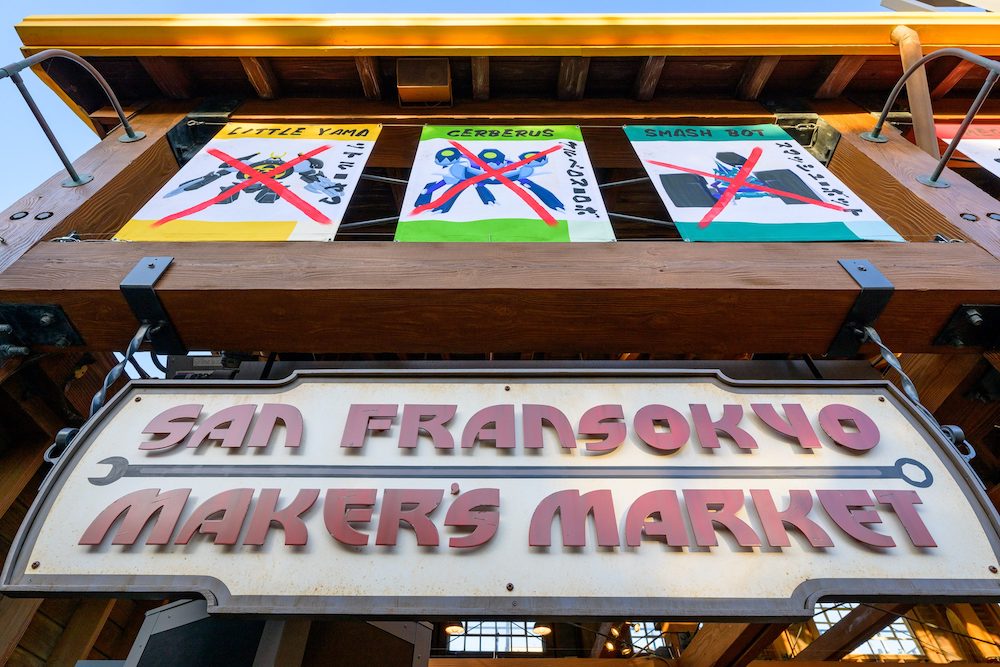
Like so much of “DCA 3.0,” its a land of extremes. San Fransokyo Square has the depth, texture, realism, “history,” color, and transportational quality that the park lacked for so long. It’s packed with new details, Japanese signage, countless “Easter eggs,” and of course, a whole lot of fun (see, Baymax-shaped sourdough bread).
But like Pixar Pier before it, it would be fair to critique the land as a minimum-effort overlay; a “quick fix” corporate mandate with no “long game” view; a “label-slapped” space that is, at its heart, “cute but dumb.” Though it’s incredibly dense and packed with props and placemaking , it would be fair to say that it all sort of amounts to just decoration.
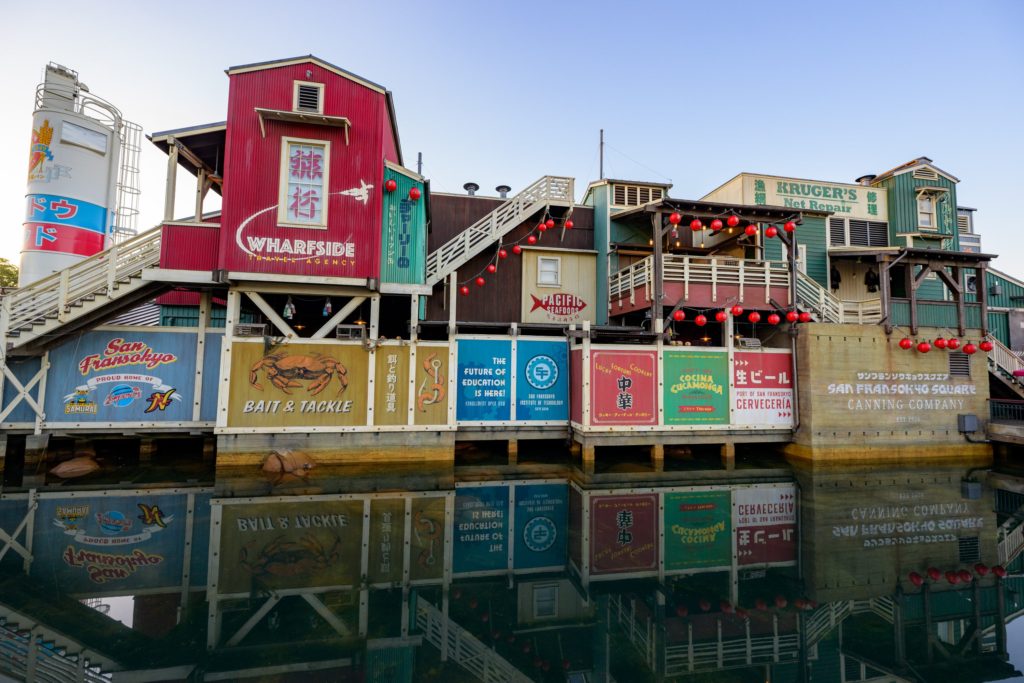
Ten years after Cars Land introduced the notion of a Disney theme park land meaningfully derived from and lovingly recreating a place seen on screen, San Fransokyo Square serves as something of an inversion on the formula. It wants to bamboozle us into thinking that maybe the place we saw in Big Hero 6 wasn’t so different from Pacific Wharf anyway, so why couldn’t just a few adjustments here and there get close enough?
Hey, it’s Instagrammable! It’s got great snacks, and fun Easter eggs, and lots of color! And like every other project to come from the “DCA 3.0” mindset, who would bother rejecting all that and pouting their way through San Fransokyo Square? Even if it’s “just decoration” and even if it doesn’t actually look like any part of San Fransokyo we saw in Big Hero 6, it probably gets close enough to the spirit and style and chaos and culture to be good enough. It’s not like Pacific Wharf was holy ground, after all.
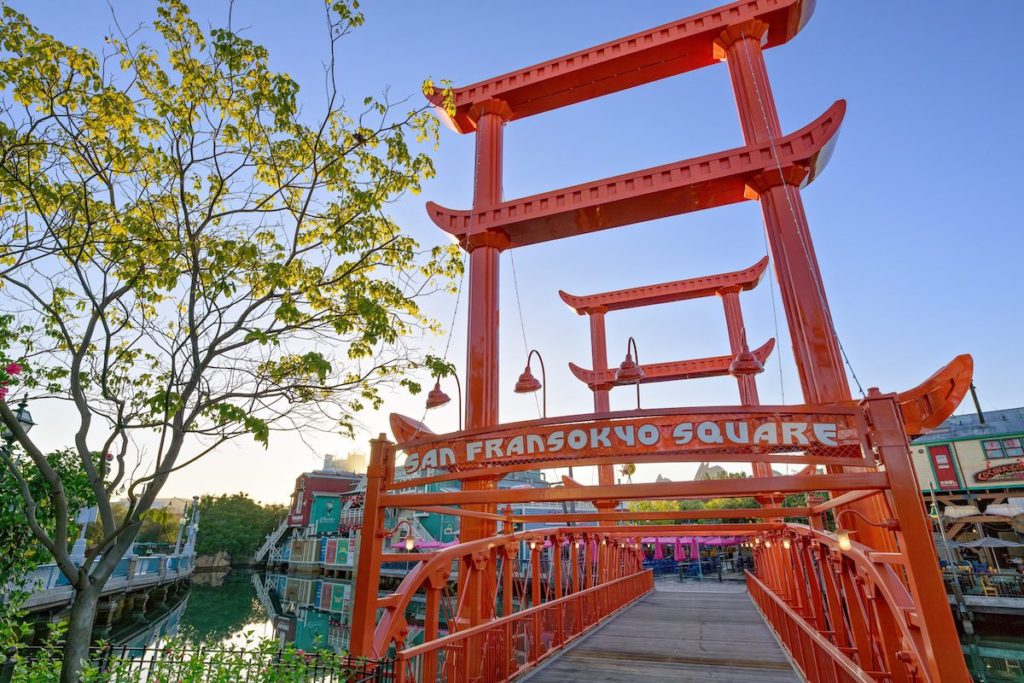
And by the way, if the primary complaint about DCA 1.0 was that it was “too much California, not enough Disney,” then certainly those critics have been silenced. To that point, one might argue that today’s California Adventure – “DCA 3.0” – is “too much Disney, not enough California.” A vast overcorrection, creating a park that – on paper – is a literal antithesis of its original self.
Of course, Horseshoe theory suggests that any two polar opposites aren’t really as far apart as they seem; that instead, on a given spectrum, the “extremes” tend to bend toward one another in surprising ways. It’s interesting to see that manifest in San Fransokyo Square where – as in so much of “DCA 3.0” – we see the faults of “DCA 1.0” anew. Richer and brighter and more historic and reverent and more texturized and wrapped in IP, of course…
But as in 2001, modernity is back in style; here, a comic book aesthetic is a good thing; here, modern pop music serves as an ambient soundtrack; here, we’re back to “DCA 1.0’s” aesthetic of reclaimed warehouses, low-cost overlays, and restaurants-over-rides. It feels a little too on-the-nose to point out that in an almost-jaw-dropping return to page 1, San Fransokyo Square includes as its entry a stretched-and-skewed, mis-proportioned, cartoonish, almost “toyetic” recreation of the Golden Gate Bridge – the very same that once served as the visual centerpiece of the park’s retired postcard entry.
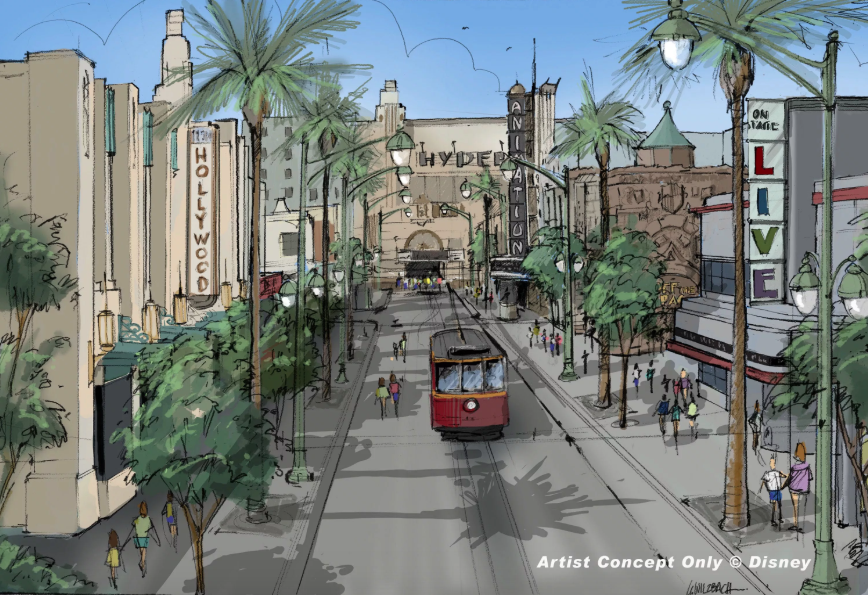
Meanwhile, while Imagineers tinker with Pacific Wharf and Paradise Pier for the umpteenth time, the park’s Hollywood Land will remain a waste of real estate with no anchor attraction… Of course, when it comes to Hollywood Land, these may indeed be “the good ole’ days” compared to whatever Disney is considering for the space, which is almost certainly centered on neither Hollywood nor California, but on a Disney, Pixar, Marvel, or Star Wars property…
Highs and lows
There’s perhaps no park on Earth that’s seen more change in the first two decades of its life than Disneyland’s second gate: from incoherent modern thrill park to story-centered Disney jewel… and maybe, back again… And that’s just the story so far.
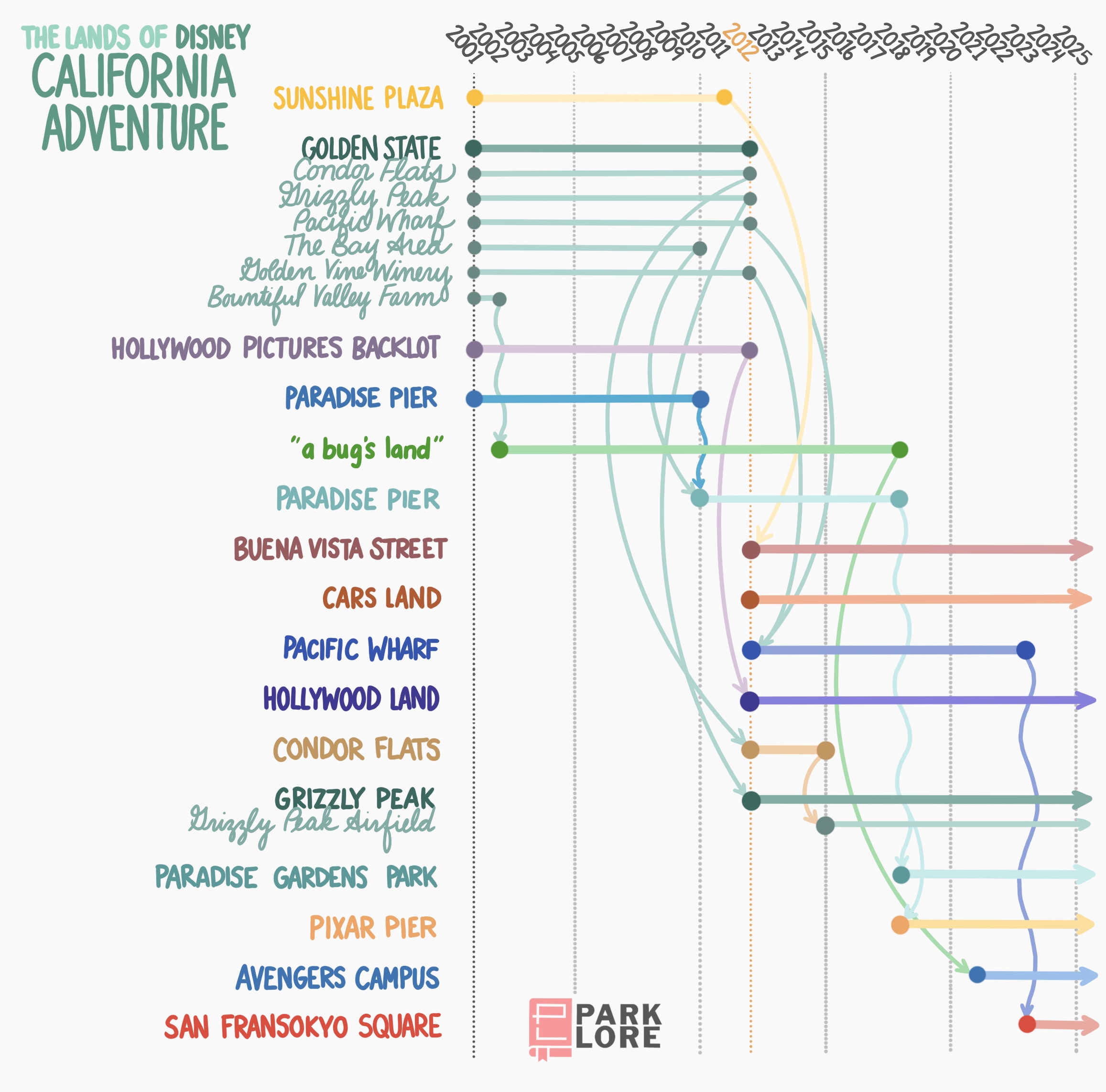
At least for now, where we’ve landed when it comes to Disney’s California misadventure is a park made of eight lands: Buena Vista Street, Hollywood Land, Avengers Campus, Cars Land, San Fransokyo Square, Grizzly Peak, Pixar Pier, and Paradise Gardens Park. (Interestingly, not one remains from the park’s Opening Day just over two decades ago.)
Disney California Adventure today is an unusual mix of old and new. Some parts of the park – like Hollywood Land – still reek of “DCA 1.0” when budgets were low and imagination scarce. Others – like Buena Vista Street, Paradise Gardens Park, and Grizzly Peak – recall the park’s 2012 rebirth and its focus on the kind of immersive, idealized M.O. it sought to make the park’s standard.
Then, post-2012 additions – like Avengers Campus, Pixar Pier, and San Fransokyo Square – double down on the texture and depth, but essentially unroot their “DCA 2.0” selves and re-tether their identities not to timeless California, but to Disney’s modern IP library in weirdly-uneven ways.
To question whether or not that’s a smart long-term strategy – i.e., “Will Guardians of the Galaxy – Mission: BREAKOUT!, Pixar Pier, or San Fransokyo Square be as timelessly relevant in 20, 30, or 50 years as the Twilight Zone Tower of Terror, Paradise Pier, or Pacific Wharf might’ve been?” – is hardly worth asking. Because right now – in the age of the Disney+ Park, the mandate is simple: Disney + Pixar + Marvel should find their way into Disneyland’s closest equivalent to a catch-all “studio” park via whatever means necessary.
One-off, piecemeal swaps are the name of the game. Following Universal’s well-trodden footsteps, Disney seems content to measure attractions’ lifetimes in seasons rather than decades if that’s what it costs to keep blockbuster brands in the park in real time. In other words, it doesn’t matter whether Guardians of the Galaxy will still reign over California Adventure in twenty years; when the time is right, the ride can simply be swapped to whatever IP is hot at that moment.
But we need not wonder about decades from now anyway. Even in the short-term, it’s worth recognizing that data consulting firm AECOM’s recent theme park attendance report estimates that California Adventure welcomed 9 million guests in 2022. That sounds like a lot, but it’s only 500,000 more than visited the park in 2013 – the first full year after Cars Land debuted! Soarin’ Around the World, Mission: BREAKOUT!, Pixar Pier, and Avengers Campus providing just a 6% boost to the park’s attendance across ten cumulative years should be a signal to Disney that quick-fixes, character overlays, and low-cost IP infusions just isn’t working... And it seems highly unlikely that the ride-less San Fransokyo Square will reverse that trend.
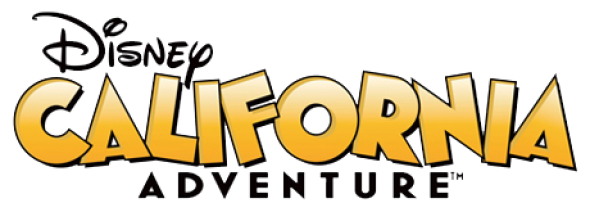
At least in today’s California Adventure, it seems no one’s really in the driver’s seat. The era of master-planned, interconnected, intentional expansion is over. One-off, piecemeal swaps are the name of the game.
And that, in some ways, brings us full circle. Today, two decades of addition and subtraction have yielded a park that’s practically unrecognizable from its Opening Day form. It’s been “plussed” by more rides, more E-Tickets, more dark rides, and more characters than anyone could’ve imagined; it has an entirely different lineup of lands; a different name; a different logo; and yes, a different spirit that can be felt throughout…
But perhaps more than ever before, Disney California Adventure is a park that’s wildly uneven. Within reside the highs and lows of Imagineering on display; sweeping eras of master-planned, cohesive connectivity, juxtaposed with areas left behind to “DCA 1.0” or artificially advanced to the new ethos of “DCA 3.0.”
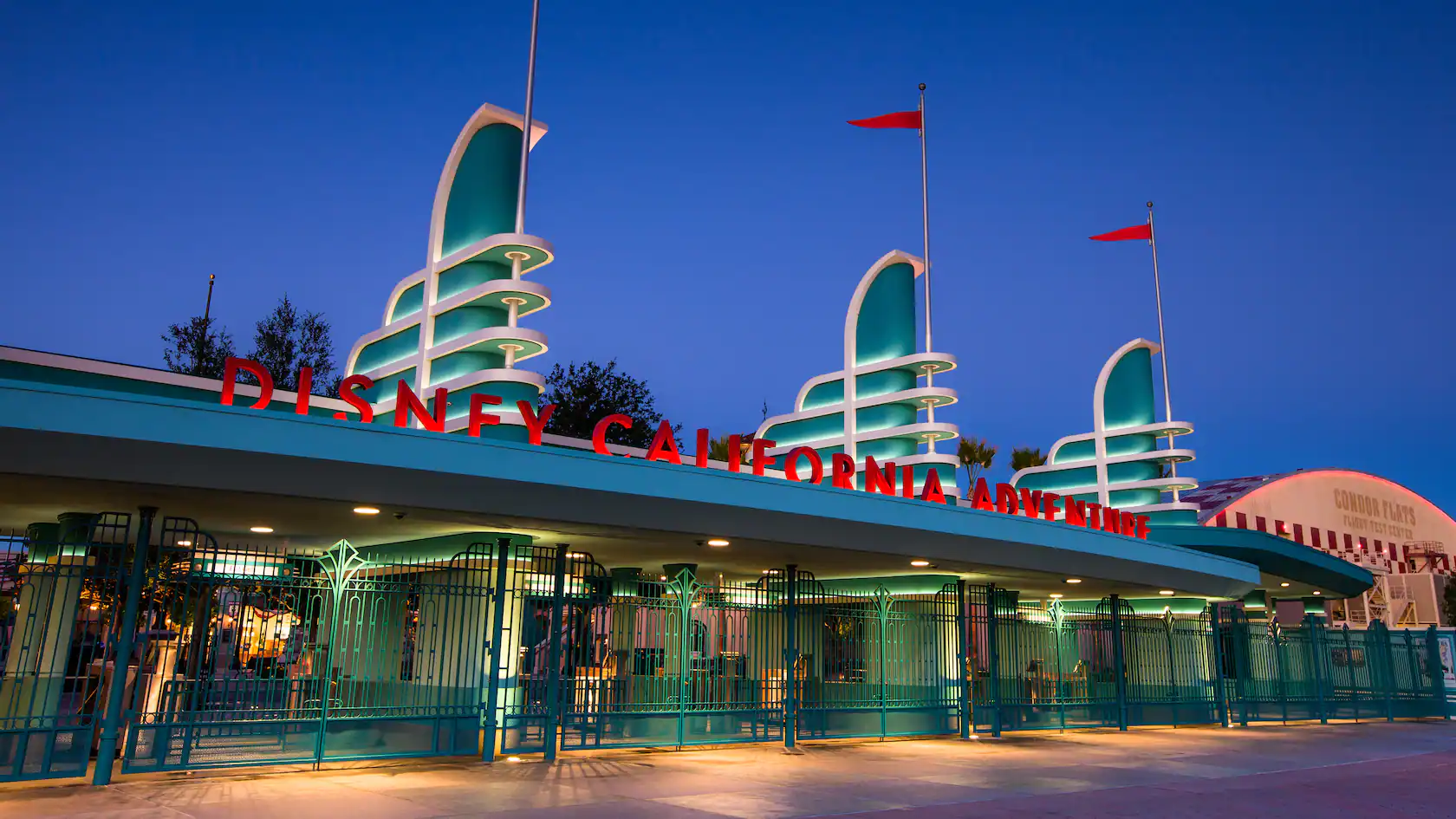
It’s a park that largely still offers beautifully-decorated lands that exude the history and magnificence of California’s storied places… but then fills them with rides themed exclusively to Cars, The Little Mermaid, Spider-Man, Monsters Inc., and Finding Nemo.
California Adventure is a park where Buena Vista Street is reigned over by a “warehouse prison power plant” grafted with pipes and satellite dishes from Marvel’s Guardians of the Galaxy; where a turn-of-the-century pier has its carnival rides “label-slapped” with The Incredibles, Toy Story, and Inside Out; where even a food court must become a stand-in for the animated, technological metropolis from Big Hero 6.
Does it work? Does “DCA 3.0” come together despite the oddities inherent in its different eras and IP overlays? We’ll let you decide. And until then, we’ll just have to get used to seeing Spider-Man, Mike and Sully, Woody and Buzz, Ariel, and Elsa and Anna enjoying a getaway in the Golden State.
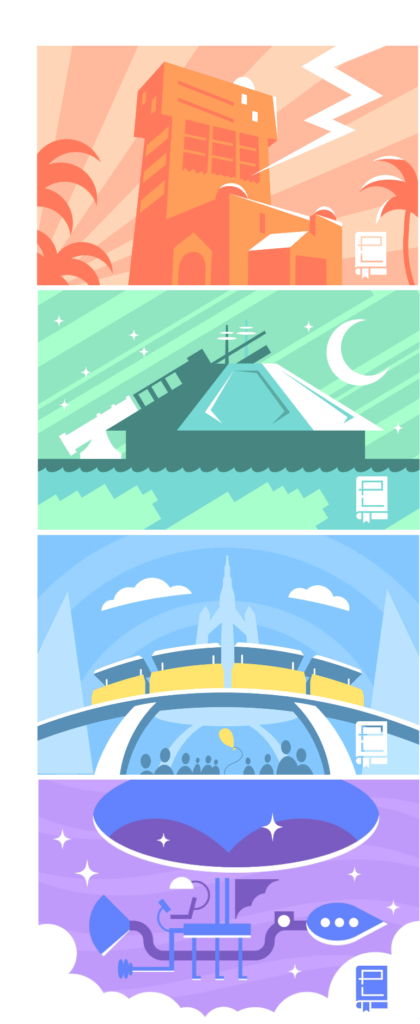
Thank you so much for reading. Now, it’s your turn to join the story. If you enjoy spending time falling down the “rabbit hole” of Park Lore’s in-depth, ad-free, member-supported stories, consider becoming a Member for as little as $2 / month.
Members can unlock rare concept art in every tale, reveal attraction audio streams in select stories, gain access to over a hundred exclusive articles in our quick-read Extra Features and in-depth Special Features collections, gain exclusive podcast extras, and receive an annual member card and merch in the mail! (Plus, y’know, supporting research-based, ad-free, clickbait-free, in-depth theme park writing!)


